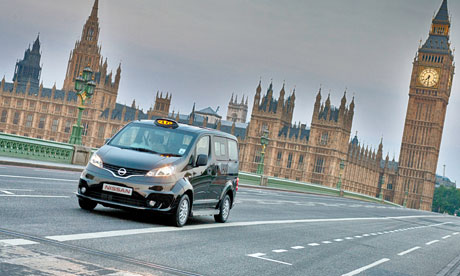
The prospect of London's black cabs going electric has come a step closer with the unveiling of a prototype that will be trialled on the capital's streets as early as next year.
Nissan has promised that its new London taxi, a van-like vehicle, can eliminate 20% of the capital's exhaust pollution caused by its 22,000 black cabs. But the carmaker warned that it was now down to politicians to make electric traffic a practical reality.
The London mayor, Boris Johnson, has pledged that a zero-emission taxi fleet will be in service by 2020, although London assembly members have queried the slow rate of installing charging points for electric vehicles.
The NV200 taxi will also be produced in a diesel engine version that Nissan claims is 50% more fuel-efficient than existing cabs. The vehicle retains the distinguishing features of London cabs – the for-hire light and the 25-foot turning circle reportedly required to drive to the Savoy hotel's front door – but also has aesthetically questionable tinted sunroofs and sliding doors.
The taxis, expected to be on general sale to cabbies by 2014, will be built in Barcelona but the electric versions will have the batteries and motors produced in Sunderland.
Andy Palmer, executive vice-president of Nissan, said the vehicles had a potential range of 200 miles a day, based on an overnight charge and a 30-minute fast charge at one of the anticipated future network of charging points.
While Nissan is also adapting the same model for Tokyo and for New York's yellow fleet, it held out the prospect of London's hackney carriages winning the race for a fully electric future.
Palmer said: "The ball was in the manufacturers' court. Now it's with the cities to see who can get the infrastructure in place.
"Charging is the big question. This needs collaboration with government and the authorities to get the range you need.
"The ENV200 will have a range of 200 miles but that relies on having chargers in the right place. There's a lot of work to be done."
Despite the possible public perception that London's cabbies may not be the most ardent environmentalists, taxi drivers' representatives were enthusiastic about an electric fleet, and not just because Nissan has promised to price its vehicle below those built by rivals the London Taxi Company and Mercedes.
Steve McNamara, general secretary of the Licensed Taxi Drivers' Association, said: "People think 'Ah, cabbies, they don't care', but we sit in traffic all day. We sit in more pollution than anyone."
He said the lack of noise from electric vehicles was the "real competitive edge" for drivers. "They're so quiet, it's so much more relaxing."
However, he cautioned against anticipating a transformed experience: "I can't promise you cheerful cabbies or interesting banter. But it can't happen soon enough."

